After attending a banquet at the Roman residence of Cardinal Pietro Aldobrandini, Fabio Massetti wrote to the Duke of Modena and Reggio, marvelling at the massed silver he had seen there. Among the glitter he ‘observed twelve [large serving dishes] with the twelve Caesars, and within sculpted all their triumphs and famous accomplishments, valued at two thousand scudi’. The date was September 1604. It is these tazze, or serving dishes, each one raised upon a foot and carrying at its centre a statuette of a Roman ruler – Julius Caesar or one of the 11 emperors up to Domitian – that visitors have been feasting their eyes on in the exhibition ‘The Silver Caesars: A Renaissance Mystery’ at the Metropolitan Museum of Art, which travels to Waddesdon Manor this month (18 April–22 July).
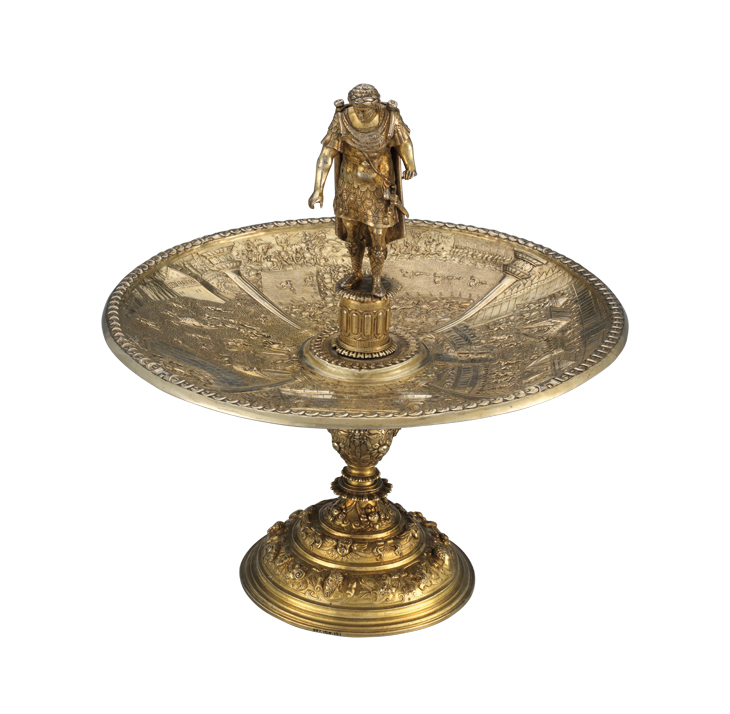
Otho figure and dish with replaced foot, figure and dish (dish: c. 1587–99; foot: after the mid 19th century), anonymous (Netherlandish?). Royal Ontario Museum, Toronto
The tazze, each weighing more than 2.5kg, and invested with an astonishingly ambitious sculptural narrative, were clearly a major commission; the mystery is that nothing is known for certain about their origins. None of the pieces bear any goldsmiths’ marks and history passes in silence over their date, authorship, place of manufacture, the name of their possible commissioner or intended recipient. Cast-iron answers prove elusive but the exhibition and its accompanying book produce forensically reasoned deductions like well-ordered rabbits from a hat. But perhaps even more rewarding is the wealth of information revealed along the way by the exhibition curator and editor Julia Siemon and the other 11 essayists.
Whoever guided the creation of the tazze had an intimate knowledge of Suetonius’s De Vita Caesarum, or Lives of the Caesars, and set out to create a carefully edited visual version of it. As the classicist Mary Beard has now identified, the narrative scenes, chased in low relief in the 48 quadrants of the concave upper surfaces of the 12 tazze, illustrate specific textual passages rather than general episodes from the emperors’ lives. In a conscious distortion of Suetonius’s candid, gossipy biographies, only encomiastic images of the Caesars and the idea of imperium are translated into metal. A Groundhog Day story, peppered with divine portents and illustrative only of success, unfolds in the sequence of scenes, arranged clockwise, on each tazze: military victory, liberality, dynastic continuity and the transmission of power. The Silver Caesars served as an ‘appeal to power and an injunction to just rule’. To whom? Almost certainly to the Habsburg Archdukes of Austria, regularly elected Holy Roman Emperor. Claimants of lineal descent from their Roman predecessors, the Holy Roman Emperors were often depicted, at least from the 16th century, in ancient imperial dress to reinforce that imagined continuum.
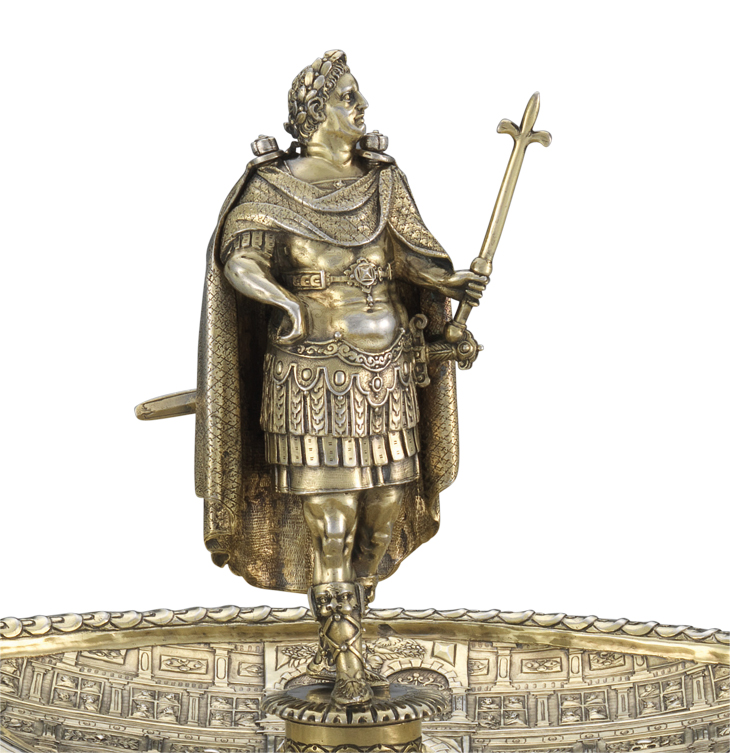
Vespasian figure and dish with replaced foot (detail; dish: c. 1587–99; foot: after the mid 19th century), anonymous (Netherlandish?). Private collection, London
A striking analogy is made between the form of the tazze and an idealised circular map of Rome, published by Marco Fabio Calvo in 1532, at the centre of which stands the milliarium aureum, a golden terminal milestone topped by a statue of Caesar Augustus. The four fluted columns that separate the scenes on each tazza diminish in an unorthodox way towards their bases, narrowing as would lines radiating from a central point, the place where each Caesar stands. Then comes the exhibition’s bombshell: it is the statuette of each emperor, not the dinner guest, nor indeed the owner of the silver, that has the most privileged view. Only thanks to detailed photography of the temporarily disassembled tazze are we now able to appreciate the virtuosity of the silversmiths’ work.
The exhibition elucidates how the 48 scenes were assembled from a dizzying array of print sources, synthesised in turn from antique sculpture, coins and works of literature. They evoke a late Renaissance idea of Rome rather than one informed by archaeology. The sources include prints after Piero Ligorio of the Port of Ostia and the Circus Maximus, published in Antonio Lafréry’s Speculum Romanae Magnificentiae; coin reverses from numismatic treatises by the likes of Hubert Goltzius, Guillaume du Choul and Enea Vico; and Onofrio Panvinio’s posthumously published De triumpho commentarius. We are told too that those creating the silver cups must also have been aware of Johannes Stradanus’s Imperatum XII, in which prints, engraved by Adriaen Collaert, place equestrian statuary portraits of the emperors against complex narrative backgrounds. The skills of the unidentified antiquarian responsible for assembling this diverse material complement the ‘joyful artistic autonomy’ of the several unidentifiable northern European silversmiths, who, it is argued, realised his conception. Licence, both spatial and temporal, is freely taken in the ‘telescoping’ together of the different elements.
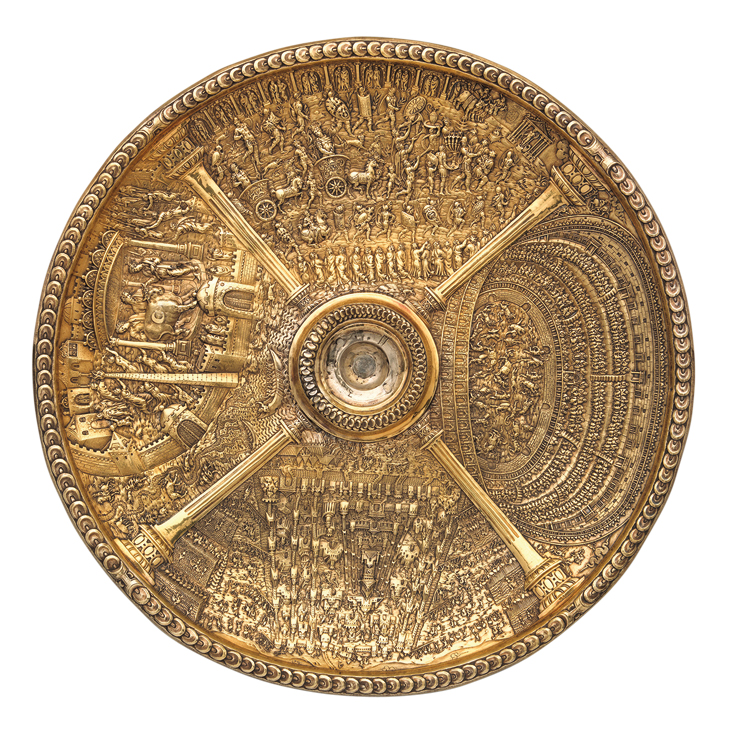
Titus dish (c. 1587–99), anonymous (Netherlandish?). Museo Nacional de Arte Antigua, Lisbon
The tazze may have been created for the celebration in Ferrara in 1598 of the Habsburg double wedding – of Philip III of Spain to his cousin Archduchess Margaret of Austria and Isabella Clara Eugenia, the Infanta, to her cousin Archduke Albert VII of Austria. Six of them may afterwards have been given to Cardinal Aldobrandini in thanks for his hospitality. Aldobrandini bought six of the tazze in Milan in 1602 and an inventory shows that all 12 were in his possession by the following year. Descending through the related Borghese, Pamphilj and Doria Pamphilj families they appear to have left Italy by the late 18th century, resurfacing with a London dealer in 1826. Six were later ‘improved’ by the dealer-collector Frédéric Spitzer to accord with 19th-century ideas of Renaissance decoration.
The tazze are easily dismantled and at some point their component parts became muddled-up; at the end of the 19th century, and by then in multiple ownerships, only two of the 12 dishes – representing Julius Caesar and Claudius – were correctly paired. In 1893, the 16th- or 17th-century manuscript thought to describe the scenes was lost. In 1956 the Victoria and Albert Museum, the Metropolitan Museum of Art and the Royal Ontario Museum exchanged their Caesar statuettes in an attempt to resolve at least a part of the confusion, but this left London the loser: the V&A’s Vitellius was swapped for Domitian only to leave the former presiding over the dish intended for Tiberius, as Mary Beard deduced in 2010. This discovery paved the way for the correct identification of all 48 scenes and the correct pairing of dishes and emperors during a symposium at the Met in 2014.
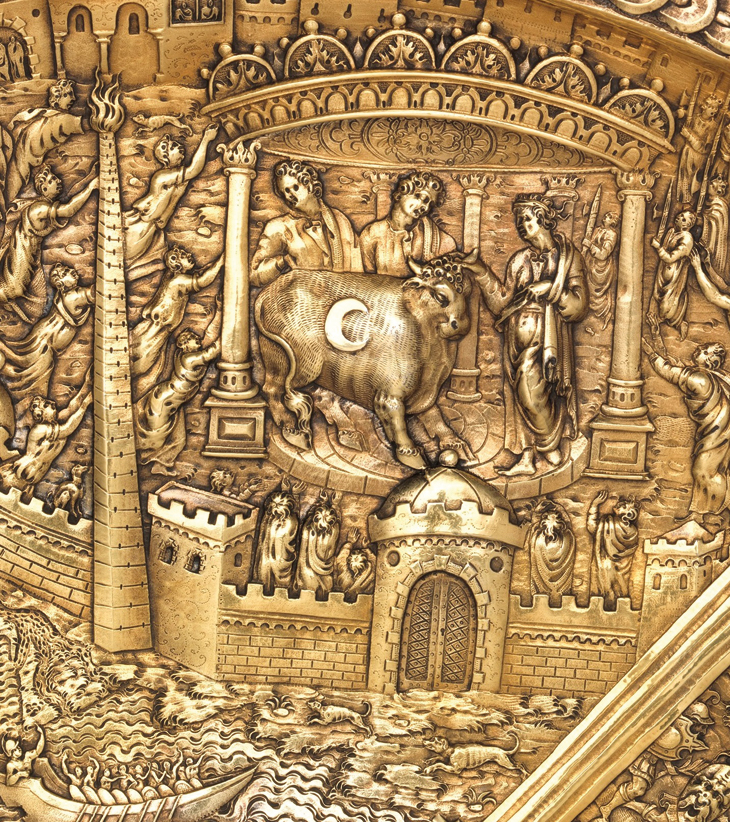
Detail from the Titus dish (see previous illustration), showing the emperor wearing a diadem and consecrating the Apis bull at Memphis on his way to Alexandria
These complications have until now further blurred any clear understanding of the Silver Caesars. However the exhibition and its associated book demonstrate in an exemplary way the dividends that flow from the open exchange of international, interdisciplinary scholarship and the stimulus of fresh ideas.
‘The Silver Caesars: A Renaissance Mystery’ was at the Metropolitan Museum of Art, New York, 12 December 2017–11 March; it is at Waddesdon Manor, Buckinghamshire from 18 April–22 July.
From the April issue of Apollo. Preview and subscribe here.
Unlimited access from just $16 every 3 months
Subscribe to get unlimited and exclusive access to the top art stories, interviews and exhibition reviews.

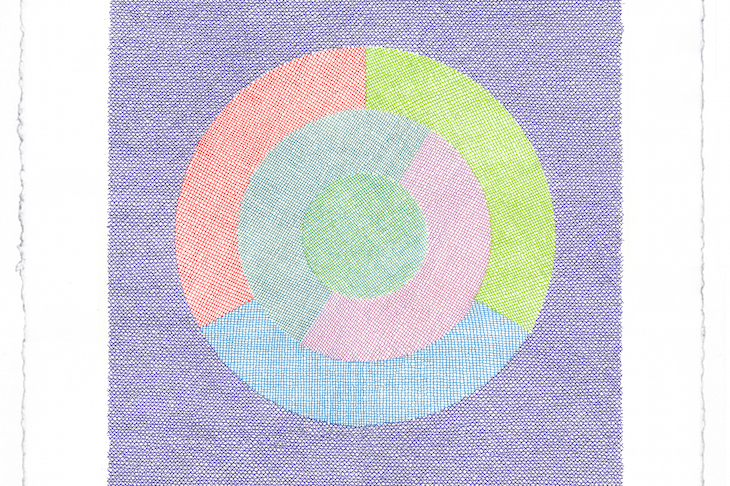
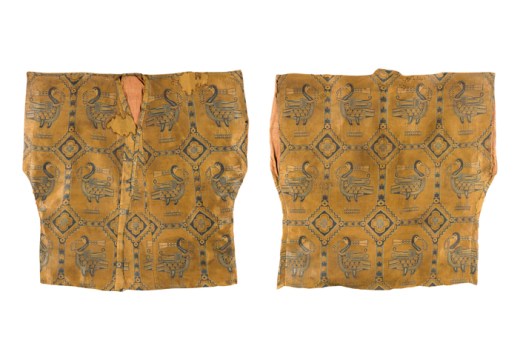

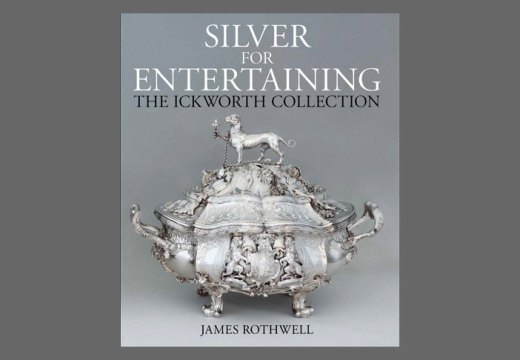









![Masterpiece [Re]discovery 2022. Photo: Ben Fisher Photography, courtesy of Masterpiece London](http://www.apollo-magazine.com/wp-content/uploads/2022/07/MPL2022_4263.jpg)
It’s time for the government of London to return to its rightful home